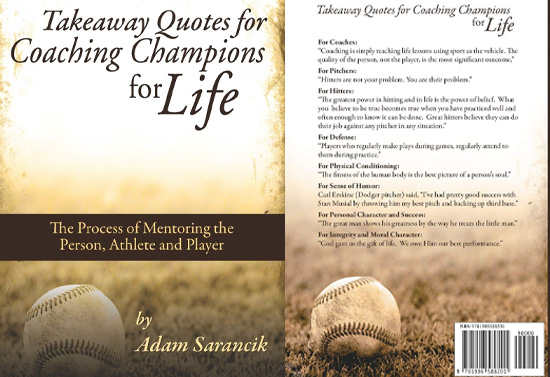
It is my philosophy that coaches at all levels must see members of their team as a three-part development project: a person, an athlete and a player. I think that sometimes coaches look at the members of their team and see only players––members of a team that, if developed properly, can help win games. I believe that in order to develop the best players, coaches must first train the athlete. And yes, before the athlete can be the best they can be, they must first be related to, connected with and validated as a
person.
The first step in getting a team member to be a good player is to get them to believe they are a good person.
At the most basic level in baseball, a coach has an option to attribute negative results to either sport skill deficiency or an athleticism deficiency.
Can you look at a
player and see the
athlete? Can you look at a pitcher and see that the first step to improving their performance might not be correcting a pitching mechanic, but might be, for example, a lack of stability in the ankles or knees? An inability to load the back hip? A lack of core mobility in the torso and thoracic spine? Can you look at a hitter and see that the first step in correcting a habit of popping up might be such things as the correction of poor hip mobility, physical instability or poor plyometric skills?
One of the most common omissions in the development of youth and high school players is the lack of an athleticism-based training component. Young players must first and foremost learn to use their bodies efficiently before they can perform the skills of their sport well. Players cannot throw or hit a ball well if they cannot properly load their back hip. Dynamic movement and plyometric routines which teach athletes how to properly crawl, walk, skip, run, backpedal, bound, sprint, jump, hop and shuffle while doing complex movements in all planes of motion are critical components of practice and training plans. They should be required by all youth leagues at every team practice and should be emphasized as essential parts for all high school strength and conditioning programs year-round.
In my experience, a pitcher with good mechanics who can bound in a smooth and powerful manner is a strike-throwing machine. When coaches understand why this is true and can teach it to their players, they will improve their ability to develop their players exponentially.
Specifically, I recommend doing two things to begin analyzing your players first as athletes before “correcting” them as
players:
- Consider the biomechanical sequencing process that leads to the result, not just the result itself. Using frame-by-frame video analysis can assist you when doing this.
- Train your eyes to look at the lower half of your player’s body before looking at their upper body. Almost all mechanical faults and fixes begin from the ground up: posture, balance, footwork, angles, rhythm and timing. Coaches must be able to do a “bottom-up” analysis of a player’s movements and to determine how efficiently they use (in succession) their feet, legs, hips, torso, shoulders, arm, wrist and fingers.
When coaches can train their players first as athletes, the long-term development of their teams and leagues will benefit greatly and they will more consistently achieve their goal of winning games and championships. When coaches mentor their team members in this order; Person-Athlete-Player, they will achieve their most important goal of Coaching Champions for Life.
Adam Sarancik is the owner of Elevate Sports Academy which trains youth in sport skills, athleticism, nutrition, and career and college counseling. He is the author of Coaching Champions for Life – The Process of Mentoring the Person, Athlete and Player and its companion book, Takeaway Quotes for Coaching Champions for Life.